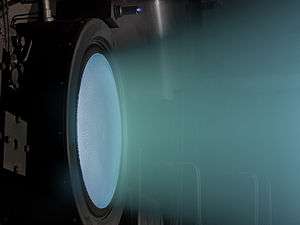NEXT (ion thruster)

The NASA Evolutionary Xenon Thruster (NEXT) project at Glenn Research Center is an ion thruster about three times as powerful as the NSTAR used on Dawn and Deep Space 1 spacecraft.[1][2]
NEXT affords larger delivered payloads, smaller launch vehicle size, and other mission enhancements compared to chemical and other electric propulsion technologies for Discovery, New Frontiers, Mars Exploration, and Flagship outer-planet exploration missions.[2] Glenn Research Center manufactured the test engine's core ionization chamber, and Aerojet Rocketdyne designed and built the ion acceleration assembly.[3][4] The first two flight units will be available in early 2019.
Performance
The NEXT engine is a type of solar electric propulsion in which thruster systems use the electricity generated by the spacecraft's solar panel to accelerate the xenon propellant to speeds of up to 90,000 mph (145,000 km/h or 40 km/s).[3] NEXT can produce 6.9 kW thrust power and 236 mN thrust.[5] It can be throttled down to 0.5 kW power, and has a specific impulse of 4190 seconds (compared to 3120 for NSTAR).[2] The NEXT thruster has demonstrated a total impulse of 17 MN·s; which is the highest total impulse ever demonstrated by an ion thruster.[2] A beam extraction area 1.6 times that of NSTAR allows higher thruster input power while maintaining low voltages and ion current densities, thus maintaining thruster longevity.[2]
Tests
In November 2010, it was revealed that the prototype had completed a 48,000 hours (5.5 years) test in December 2009.[3][5][6] Thruster performance characteristics, measured over the entire throttle range of the thruster, were within predictions and the engine showed little signs of degradation and is ready for mission opportunities.[2]
Status
NEXT completed its System Requirement Review in July 2015 and Preliminary Design Review in February 2016. The first two flight units will be available in early 2019.[7] The CAESAR mission concept to comet 67P/Churyumov–Gerasimenko is a finalist for the New Frontiers program mission #4, and if selected in 2019, it will be propelled by the NEXT ion engine.[8] After that, it will be a commercial product for purchase by NASA and non-NASA customers.[7] Aerojet Rocketdyne, and their major sub-contractor ZIN Technologies retain the rights to produce the system, known as NEXT-C for future commercialization.[7]
See also
References
- ↑ George R Schmidt; Michael J Patterson; Scott W Benson. "The NASA Evolutionary Xenon Thruster (NEXT): the next step for US deep space propulsion" (PDF).
- 1 2 3 4 5 6 Herman, Daniel A. (May 3–7, 2010), "NASA's Evolutionary Xenon Thruster (NEXT) Project Qualification Propellant Throughput Milestone: Performance, Erosion, and Thruster Service Life Prediction After 450 kg" (PDF), 57th Joint Army-Navy-NASA-Air Force (JANNAF) Propulsion Meeting, Colorado Springs, Colorado, USA: NASA - Glenn Research Center, retrieved 2014-03-08
- 1 2 3 Dwayne Brown; Katherine K. Martin; Glenn Mahone. "NASA Thruster Achieves World-Record 5+ Years of Operation". Retrieved 2013-06-24.
- ↑ NASA Thruster Achieves World-Record 5+Years of Operation. NASA. June 24, 2013.
- 1 2 David Szondy. "NASA's NEXT ion thruster runs five and a half years nonstop to set new record". Retrieved 26 June 2013.
- ↑ Nancy Smith Kilkenny, SGT, Inc. "NEXT Provides Lasting Propulsion and High Speeds for Deep Space Missions". Retrieved 29 September 2013.
- 1 2 3 Dolloff, M.; Jackson, J. (March 2016). Current Status of NASA Evolutionary Xenon Thruster - Commercial (NEXT-C) (PDF). 47th Lunar and Planetary Science Conference.
- ↑ "CAESAR Project Overview" (PDF). Lunar and Planetary Institute. 17 January 2018. Retrieved 2018-01-19.